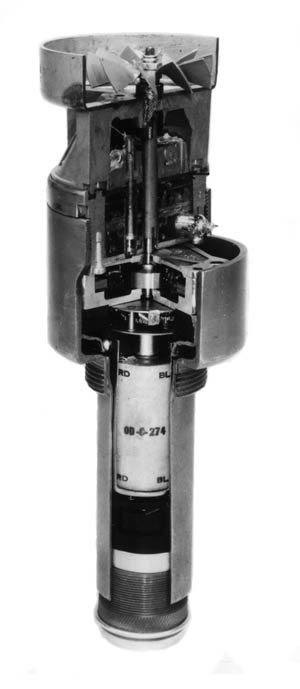
| Historical Information | |||||
| Caption | Cutaway view of a proximity fuze for aerial bombs developed by Section E for the United States Army Air Corps. Rather than relying on a battery, this design employs a turbine driven by external blades. ww2dbase | ||||
| Date | 1944 | ||||
| Photographer | Unknown | ||||
| Source Information | |||||
| Source | ww2dbaseUnited States National Bureau of Standards | ||||
| Related Content | |||||
| More on... |
| ||||
| Licensing Information | |||||
| Licensing | This work is believed to be in the public domain. Please contact us regarding any inaccuracies with the above information. Thank you. |
||||
| Metadata | |||||
| Added By | David Stubblebine | ||||
| Photo Size | 300 x 689 pixels | ||||
Please consider supporting us on Patreon. Even $1 per month will go a long way! Thank you. Please help us spread the word: Stay updated with WW2DB: |
Visitor Submitted Comments
All visitor submitted comments are opinions of those making the submissions and do not reflect views of WW2DB.
Search WW2DB
News
- » US Women's Army Corps "Six Triple Eight" Awarded with Congressional Gold Medal (30 Apr 2025)
- » Wreck of Soviet Submarine M-49 Found (10 Apr 2025)
- » Japanese Emperor Visited Iwoto (Iwo Jima) (8 Apr 2025)
- » Race, Holocaust, and African-American WW2 Histories Removed from the US Naval Academy Library (7 Apr 2025)
- » US Government Plans to Purge WW2 Information (17 Mar 2025)
- » See all news
Random Photograph
Men of US 7th Division waiting outside a Japanese blockhouse on Kwajalein while a flamethrower did its work, Marshall Islands, 4 Feb 1944Current Site Statistics
- » 1,167 biographies
- » 337 events
- » 44,642 timeline entries
- » 1,244 ships
- » 350 aircraft models
- » 207 vehicle models
- » 376 weapon models
- » 123 historical documents
- » 261 facilities
- » 470 book reviews
- » 28,517 photos
- » 365 maps
Famous WW2 Quote
"An appeaser is one who feeds a crocodile, hoping it will eat him last."Winston Churchill
Support Us
Please consider supporting us on Patreon. Even $1 a month will go a long way. Thank you!
Or, please support us by purchasing some WW2DB merchandise at TeeSpring, Thank you!
5 Jul 2021 09:11:05 PM
Section E worked in parallel with Section T but Section E developed fuzes primarily for United States Army unrotated weapons whereas Section T’s priority all along was to develop and anti-aircraft fuze for the Navy’s 5-inch guns. Fuzes for aerial bombs required an alternate source of electricity since the intense cold at high altitudes made batteries unreliable.